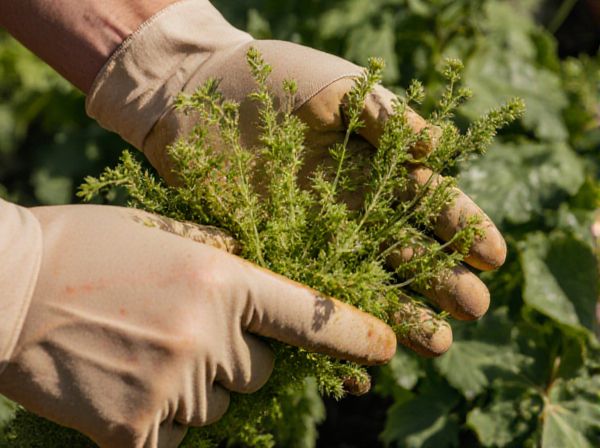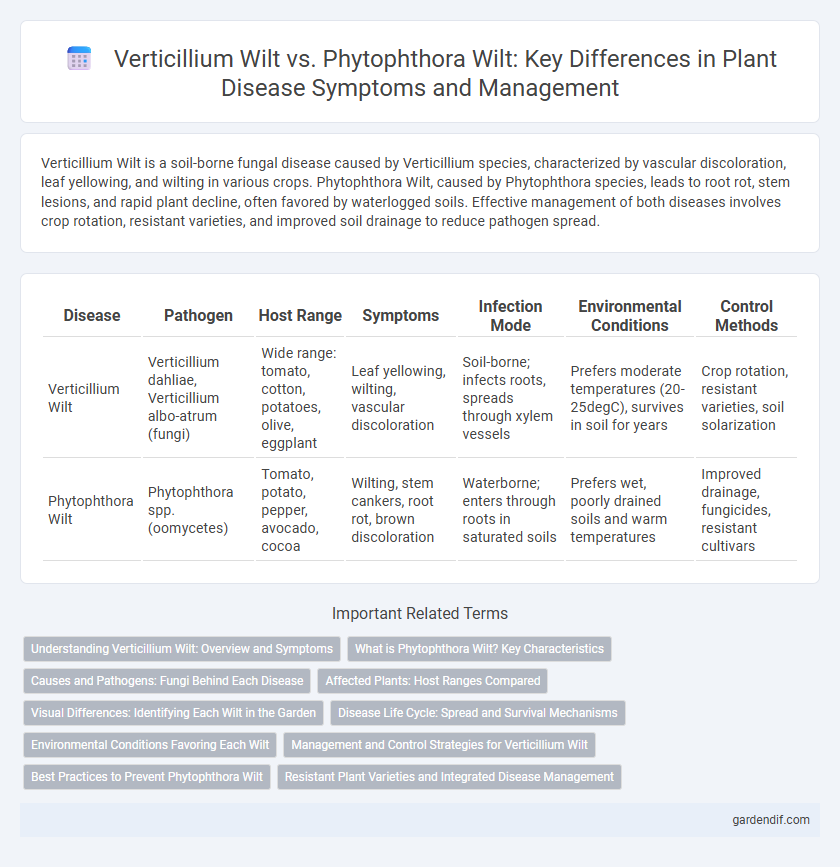
Verticillium Wilt vs Phytophthora Wilt Illustration
Verticillium Wilt is a soil-borne fungal disease caused by Verticillium species, characterized by vascular discoloration, leaf yellowing, and wilting in various crops. Phytophthora Wilt, caused by Phytophthora species, leads to root rot, stem lesions, and rapid plant decline, often favored by waterlogged soils. Effective management of both diseases involves crop rotation, resistant varieties, and improved soil drainage to reduce pathogen spread.
Table of Comparison
| Disease | Pathogen | Host Range | Symptoms | Infection Mode | Environmental Conditions | Control Methods |
|---|---|---|---|---|---|---|
| Verticillium Wilt | Verticillium dahliae, Verticillium albo-atrum (fungi) | Wide range: tomato, cotton, potatoes, olive, eggplant | Leaf yellowing, wilting, vascular discoloration | Soil-borne; infects roots, spreads through xylem vessels | Prefers moderate temperatures (20-25degC), survives in soil for years | Crop rotation, resistant varieties, soil solarization |
| Phytophthora Wilt | Phytophthora spp. (oomycetes) | Tomato, potato, pepper, avocado, cocoa | Wilting, stem cankers, root rot, brown discoloration | Waterborne; enters through roots in saturated soils | Prefers wet, poorly drained soils and warm temperatures | Improved drainage, fungicides, resistant cultivars |
Understanding Verticillium Wilt: Overview and Symptoms
Verticillium Wilt, caused by the soil-borne fungus Verticillium dahliae, primarily affects vascular tissues, leading to wilting, chlorosis, and leaf necrosis in host plants. Symptoms include yellowing and browning of leaves, stunted growth, and vascular discoloration visible in cross-sections of stems. Unlike Phytophthora Wilt, which is caused by oomycetes and often results in root rot and rapid plant collapse, Verticillium Wilt progresses more slowly and persists in soil for many years, making disease management challenging.
What is Phytophthora Wilt? Key Characteristics
Phytophthora Wilt is a destructive plant disease caused by Phytophthora species, notorious for its water mold classification and aggressive nature in soil-borne infections. Characterized by rapid wilting, root rot, and clove-shaped lesions on stems and roots, it thrives in wet, poorly drained soils, leading to the decay of vascular tissues and impaired water transport. Key diagnostic features include brown, water-soaked lesions, extensive root necrosis, and the presence of zoospores that facilitate disease spread in saturated environments.
Causes and Pathogens: Fungi Behind Each Disease
Verticillium Wilt is caused by soil-borne fungi Verticillium dahliae and Verticillium albo-atrum, which invade plant vascular tissues leading to wilting and vascular discoloration. Phytophthora Wilt results from infection by oomycete pathogens in the Phytophthora genus, notably Phytophthora infestans and Phytophthora sojae, causing root rot and systemic plant decline. Both diseases involve fungal-like organisms attacking plant roots and vascular systems, yet differ in pathogen taxonomy and disease progression mechanisms.
Affected Plants: Host Ranges Compared
Verticillium wilt primarily affects a wide range of crops including tomatoes, potatoes, cotton, and various woody plants, while Phytophthora wilt targets a more specific set of hosts such as soybeans, avocados, and other fruit trees. Verticillium species thrive in cooler soil conditions, making them prevalent in temperate regions, whereas Phytophthora species prefer wetter, poorly drained soils typical of subtropical and tropical climates. Understanding the host ranges and environmental preferences of Verticillium and Phytophthora wilts is crucial for implementing effective crop rotation and disease management strategies.
Visual Differences: Identifying Each Wilt in the Garden
Verticillium Wilt typically presents as yellowing and browning of the lower leaves, often with a distinct V-shaped necrosis pattern, while Phytophthora Wilt causes rapid wilting and dark, water-soaked lesions primarily at the stem base. Verticillium's vascular discoloration appears brown and streaky within the stem, contrasting with the dark, mushy stem rot characteristic of Phytophthora infections. Gardeners can identify Verticillium Wilt by its slow progression and uneven leaf symptoms, whereas Phytophthora Wilt leads to sudden plant collapse with evidence of root and stem crown decay.
Disease Life Cycle: Spread and Survival Mechanisms
Verticillium Wilt persists in soil through dormant microsclerotia, which germinate upon root contact to infect host plants, spreading via infected plant debris and water movement. Phytophthora Wilt survives as motile zoospores in saturated soils, infecting roots primarily during warm, wet conditions, and spreads rapidly through water flow and contaminated equipment. Understanding these distinct survival structures and dispersal methods is crucial for implementing targeted disease management strategies.
Environmental Conditions Favoring Each Wilt
Verticillium wilt thrives in well-drained, cooler soils with temperatures ranging between 65degF and 80degF, often exacerbated by drought stress and heavy clay soils that restrict root growth. In contrast, Phytophthora wilt favors waterlogged, poorly drained soils with high soil moisture and warm temperatures above 70degF, conditions that promote the proliferation of its aquatic zoospores. Both pathogens are influenced by soil pH and organic matter, but Phytophthora wilt is more aggressive in saturated environments where oxygen availability is limited.
Management and Control Strategies for Verticillium Wilt
Management of Verticillium wilt emphasizes crop rotation with non-host plants and the use of resistant cultivars to reduce soil inoculum. Soil fumigation and solarization can lower pathogen levels, while proper irrigation practices help minimize stress on plants, decreasing susceptibility. Biological control agents such as Trichoderma spp. and Bacillus subtilis show promise in suppressing Verticillium dahliae in agricultural systems.
Best Practices to Prevent Phytophthora Wilt
Preventing Phytophthora wilt requires implementing strict sanitation protocols, including using disease-free planting material and ensuring proper field drainage to reduce soil moisture that favors pathogen development. Crop rotation with non-host plants and the application of fungicides like mefenoxam significantly reduce the risk of infection. Monitoring soil health and resistant cultivars further enhance prevention strategies against Phytophthora-induced wilt.
Resistant Plant Varieties and Integrated Disease Management
Verticillium Wilt-resistant plant varieties exhibit genetic traits that enable them to suppress the colonization and spread of Verticillium spp., whereas Phytophthora Wilt-resistant cultivars possess mechanisms to inhibit Phytophthora spp. infection, such as enhanced root structure and immune response. Integrated Disease Management for both involves crop rotation with non-host species, soil fumigation or solarization, and the use of biological control agents like Trichoderma spp. for Verticillium wilt, while chemical fungicides targeting oomycetes and improved drainage systems are critical for Phytophthora wilt control. Employing resistant varieties combined with cultural practices and targeted chemical treatments significantly reduces disease incidence and improves crop yield stability.
Verticillium Wilt vs Phytophthora Wilt Infographic

 gardendif.com
gardendif.com